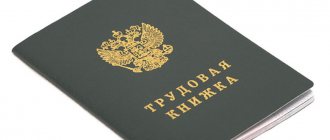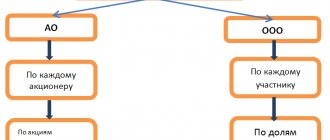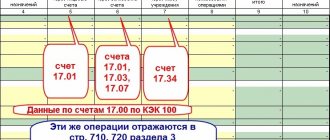How to prepare documents for debiting from account 21?
Good afternoon! While activists or staff forum experts have not answered your question, look at the materials that were automatically found on the topic of your question. Perhaps they will be useful to you. After viewing the materials, please answer the question whether this information helped you. If the information helps, click “Yes.” If the links are not useful, click “No”. News and articles Arbitration practice in May 2021: request for documents when checking a counterparty, return of advance payment when switching from the simplified tax system to OSNO, incorrect OKTMO in the payment order June 25, 2018 The concept of an adjustment invoice has appeared in the Tax Code 22 July 2011How long should documents “live” in the accounting department October 8, 2008Online cash registers – 2018 in questions and answers March 14, 2018Questions on the forum What documents are used to formalize debiting from off-balance sheet account 21 in budget accounting? March 21, 2018How to change the materially responsible person and structural unit in 1C 8.3 in materials transferred for operation? February 17, 2017 Primary document for writing off fixed assets worth up to 3,000 rubles October 14, 2015 How to write off a digital camera in a municipal institution? November 2, 2017
Selling from an off-balance sheet account
Often, the management of an enterprise decides to sell property that is in operation. In this case, the accountant is required to write off the value of the asset to the credit of a specified off-balance sheet account. In this case, income from sales, and, as a consequence, expenses, are necessarily reflected in the form of accrued value added tax. In parallel, tax accounting reflects income from sales, which should be included in the income tax return. To avoid distortion of the financial result and the tax base, the purchase price of the sold asset is not reflected in accounting and tax accounting, since it was already taken into account at the time of commissioning.
What document should I use to write off balances from an off-balance sheet account?
Ø
Get your work in order using the 1C configuration “IT Department Management 8”
ATTENTION!
If you have lost the message input window, press Ctrl-F5
or
Ctrl-R
or the Refresh button in the browser.
The thread has been archived. Adding messages is not possible.
But you can create a new thread and they will definitely answer you!
Every hour there are more than 2000
people on the Magic Forum.
How to write off materials from an off-balance sheet account?
Inventory assets (TMV) include inventories, finished products, goods (clause 3.15 of the Methodology for Inventory, approved by order of the Ministry of Finance of the Russian Federation dated June 13, 1995 No. 49).
IMPORTANT! Maintaining off-balance sheet accounting is the responsibility of a legal entity (Law “On Accounting” dated December 6, 2011 No. 402-FZ, clause 5 PBU 1/08) in order to comply with the requirement for the reliability of reporting
An entrepreneur is not obliged to keep accounting, but can do it on his own initiative - in this case, off-balance sheet transactions should also be reflected correctly.
Inventory and inventory items are recorded on off-balance sheet accounts in the following cases:
- Acceptance for storage - this is what the account is intended for. 002 “Inventory and materials accepted for safekeeping” of the Chart of Accounts (approved by order of the Ministry of Finance of the Russian Federation dated October 31, 2000 No. 94n).
- Acceptance of materials from other companies for processing - records of these operations are kept on the account. 003 “Materials accepted for processing.”
- Commission agents account for goods for resale on the account. 004 “Goods accepted for commission.”
| Debit | Credit | Contents of operation |
| 002 | Acceptance of inventory items for storage | |
| 002 | Disposal of inventory items accepted for storage |
Write-off of inventory items from the account. 002 is carried out on the basis of:
- form MX-3 or a similar document developed by the organization (taking into account the requirements of paragraph 2 of Article 9 of Law No. 402-FZ) to record the return of valuables accepted under a storage agreement;
- TORG-12, UPD or other documents - upon disposal of inventory items that were taken into account on the account. 002 within the framework of the supply agreement.
| Debit | Credit | Contents of operation |
| 003 | Received materials for processing | |
| 003 | Recycled materials were transferred to the customer |
| Debit | Credit | Contents of operation |
| 003 | Received materials for processing | |
| 003 | Customer-supplied raw materials are transferred to production | |
| 002 | Products made from customer-supplied materials have been capitalized | |
| 002 | Manufactured products were transferred to the customer |
With account 003 materials are written off based on:
- report on the consumption of customer-supplied raw materials (Article 713 of the Civil Code of the Russian Federation);
- work acceptance certificate;
- invoice M-15 or other similar documentation agreed upon by the parties.
| Debit | Credit | Contents of operation |
| 004 | Goods received under a commission agreement were capitalized | |
| 004 | Products accepted for commission were sold |
Write-off of inventory items from an off-balance sheet account. 004 is carried out on the basis of the primary document drawn up upon the sale of valuables - TORG-12, invoice, UPD or other documentation agreed upon by the parties to the commission agreement.
An organization can take into account not only other people's material assets on its balance sheet, but also its own. An example would be low-value property, household supplies and inventory that are used for more than 1 year, costing less than the limit for accepting an object for accounting as fixed assets (the organization sets this limit independently in its accounting policy, but it cannot be more than 40,000 rubles in accordance with p. 5 PBU 6/01).
Such materials are written off as expenses at a time. But due to the long period of use, it is necessary to organize control over their safety. For this purpose, you can create a record sheet for household supplies and equipment in use, or you can keep off-balance sheet accounting. In the Chart of Accounts, approved. By order No. 94n, there is no special account for these purposes, so the organization can develop an off-balance sheet account independently and approve the chosen procedure for writing off low-value materials in the accounting policy.
| Debit | Credit | Contents of operation |
| 20, 23, 25, 26, 29, 44 | 10 | Released from inventory warehouse |
| Off-balance sheet account “Inventory and household supplies” | Inventory and materials transferred into operation are registered | |
| Off-balance sheet account “Inventory and household supplies” | Inventory written off |
Such inventory items are written off from the off-balance sheet account:
- after they are completely worn out, an MB-8 act or another document is drawn up, developed taking into account the requirements for mandatory details (clause 2 of article 9 of law No. 402-FZ);
- sale, gratuitous transfer and other disposal.
Inventory. Accounting for material assets on off-balance sheet accounts.
When taking inventory, the commission must, in the presence of materially responsible persons, verify the actual availability of inventory items by recalculating, re-measuring or re-weighing. When storing inventory items in different warehouses with one materially responsible person, inventory is carried out sequentially by storage location. Within one warehouse, the recalculation of valuables is carried out in the order of their location in the storage room.
The results of the inventory are entered into the inventory list of inventory items in form No. INV-3 for each individual item, indicating the quantity, type, group, article and other necessary characteristics. If discrepancies and inaccuracies are detected in the name or main characteristics of inventory items, the correct information is indicated in the inventory.
Inventory assets received during the inventory must be received after the inventory according to the register or commodity report. During the inventory, these values are entered into a separate inventory, which is called “Inventory assets received during the inventory.” The inventory indicates the date of receipt, the name of the supplier, the date and number of the receipt document, the name of the product, quantity, price and amount, and on the receipt document an o is made with reference to the date of the inventory. If, as a result of production necessity, valuables are released during the inventory, the released values are entered in a separate inventory under the title “Inventory items released during the inventory.” An inventory is drawn up by analogy with documents for incoming inventory items during inventory.
For inventory items in transit, a separate inventory report of materials and goods in transit is drawn up in the INV-6 form. This act provides the following data for each individual shipment: name, quantity and value, date of shipment, as well as the list and numbers of documents on the basis of which these values are recorded in the accounting accounts.
For inventory items shipped and not paid for on time, an inventory report of goods shipped in the INV-4 form is generated. The act for each individual shipment contains the name of the buyer, the name of the inventory items, the amount, the date of shipment, the date of issue and the number of the payment document.
For inventory items stored in warehouses of other organizations, an inventory list is formed in the INV-5 form. Entries in the inventory are entered on the basis of documents confirming the delivery of these valuables for safekeeping. The inventory indicates the name of the valuables, quantity, grade, cost (according to accounting data), date of acceptance of the cargo for storage, storage location, numbers and dates of documents.
The inventory of inventory items that are not under the control of financially responsible persons at the time of inventory consists of checking the validity of the amounts listed in the relevant accounting accounts. Amounts must be supported by properly executed primary documents.
Containers are reflected in inventories by type, intended purpose and quality condition. For containers that have become unusable, the inventory commission draws up a write-off report indicating the reasons for the damage.
If, as a result of the inventory, discrepancies are revealed between the actual availability and accounting data, a comparison sheet of the results of the inventory of inventory items is formed according to form No. INV-19. The assessment of unaccounted for values identified by the inventory must be made taking into account market prices. Surpluses and shortages of inventory items identified during inventory are reflected in the organization’s accounting records. Material assets that do not belong to the organization are recorded in off-balance sheet accounts. To summarize information about the availability and movement of inventory items accepted for safekeeping, account 002 “Inventory items accepted for safekeeping” is used. Buying organizations record inventory items on account 002 in the following cases:
• receiving goods and materials from suppliers for which the organization legally refused to accept invoices of payment requests and pay them;
• receiving from suppliers unpaid inventory items that are prohibited from being spent under the terms of the contract until they are paid;
• acceptance of inventory items for safekeeping for other reasons.
Supplier organizations record in account 002 goods and materials paid for by buyers, which are left in safekeeping, issued with safekeeping receipts, but not removed for reasons beyond the control of the organizations. Inventory and materials are recorded on account 002 at the prices provided for in acceptance certificates or in payment request accounts. Analytical accounting for account 002 is carried out by owner organizations, by types and grades of materials, and places of their storage.
To summarize information about the availability and movement of raw materials and customer materials accepted for processing (raw materials supplied by customers), not paid for by the manufacturer, account 003 “Materials accepted for processing” is intended. Accounting for the costs of processing or refining raw materials and materials is carried out on production cost accounts, reflecting the associated costs (with the exception of the cost of raw materials and materials of the customer).
Off-balance sheet accounting of own property
To record your own material assets on the balance sheet, there are only two accounts: Advertising Disable
- account 006 “Strict reporting forms”;
- account 011 “Fixed assets leased out”.
These accounts will be useful for organizations with relevant specifics.
Thus, on account 006 you can take into account subscriptions, diplomas, shipping documents and other strict reporting forms. These documents reflect the balance sheet in the conditional valuation.
If a company rents out its property, off-balance sheet accounting may be necessary. It is necessary to reflect the leased fixed assets on account 011 if the agreement provides for accounting of the property on the balance sheet of the tenant (lessee). If there is no such condition, the lessor keeps records of fixed assets as usual - on balance sheet account 01. The lease is reflected in the debit of account 011. When the tenant returns the property, the lessor will write it off with an entry in the credit of account 011.
Advertising Disable
Off-balance sheet accounting
Off-balance sheet accounts, like regular accounting accounts, are a two-way table: debit and credit.
Accounting for off-balance sheet accounts is carried out using a simple system.
Double entry on off-balance sheet accounts is not used, that is, when making entries on off-balance sheet accounts, there is no need to reflect the same amount in the debit of one account and the credit of another account.
The debit of off-balance sheet accounts reflects the receipt of property, receipt and issuance of security, and the credit reflects the disposal of property and termination of security.
The balance at the beginning of the month reflects the availability of the type of funds accounted for in the account.
The debit reflects the receipt, and the credit reflects the write-off of these funds.
The balance at the end of the month by debit shows the balance of funds at the end of the month and is calculated using the formula:
Balance at the end of the month = Balance at the beginning of the month + Debit turnover - Credit turnover.
The ending balance of such an account is always a debit.
Still have questions about accounting and taxes? Ask them on the accounting forum.
How to register the sale of off-balance sheet accounts
Skip to content
Introductory part Most companies have assets that meet the criteria for fixed assets, and the value of which does not exceed 40,000 rubles. for a unit. These are tools, overalls, various equipment, etc.
Such objects are most often included in inventories (MPI) on the basis of paragraph 5 of PBU 6/01 “Accounting for fixed assets”. In this case, the value of the asset is reflected in account 10 “Materials”.
Then, after commissioning, they are written off to one of the “cost” accounts (for example, account 26 or account 44). At the same time, the cost of the object is reflected in the debit of the off-balance sheet account intended for accounting for inventory and household supplies in operation.
This is necessary to control the safety of the asset, its movement between workshops, departments, etc.
fixed assets leased by the enterprise;
- property received for free use;
- materials and raw materials accepted from suppliers for processing;
- equipment accepted from customers for subsequent installation;
- goods accepted for commission;
- property in safekeeping:
- valuables sent by suppliers to the enterprise by mistake;
- defects from suppliers that have not passed acceptance;
- property released to buyers according to documents, but not actually taken by them from the enterprise.
For material assets that are the property of other economic entities, their balance sheet accounting is already carried out by enterprises and organizations to which they belong by right of ownership, and off-balance sheet accounting of material assets is necessary in order to exclude the possibility of their repeated balance sheet accounting at another enterprise.
Types of off-balance sheet accounts
Off-balance sheet accounts can reflect different types of assets and liabilities. Other people's property can be taken into account:
- OS leased to the company (account 001);
- Inventory and materials that have been accepted for safekeeping (account 002);
- customer-supplied raw materials accepted for processing (account 003);
- goods received by commission agents under a commission agreement (account 004);
- equipment received by the contractor to perform installation work (invoice 005).
To account for strict reporting forms (tickets, diplomas, etc.), account 006 of the same name is used.
To establish the possibility of debt collection in the event of a change in the debtor's property status, written off receivables are recorded in account 007.
Account 008 records guarantees and other types of security received to secure the fulfillment of obligations. Collateral issued to the organization itself is accounted for in account 009.
To account for the wear and tear of housing stock, road and forestry facilities, etc. account 010 is used.
And finally, account 011 is used to account for fixed assets that the company leases when, according to the terms of the agreement, the property is listed on the tenant’s balance sheet.
The indicated 11 types of accounts and their purpose are provided for by the chart of accounts approved by the Ministry of Finance in Order No. 94n. At its discretion, the organization may use other types of off-balance sheet accounts.
The act of writing off material assets. sample 2018
Total… signatures) (position)(signature)(signature decoding) (position)(signature)(signature decoding) Download the document » Download a sample document “Act on writing off non-financial assets from the off-balance sheet accounting of an educational institution” Appendices to the document: What other documents are there: What more download on the topic “Act”:
Samples and standard forms of documents generated as a result of the execution of the state function of monitoring and coordinating the activities of state budgetary institutions of the Moscow region.
Samples on the topic: Act, Accounting, Education, Finance Approved by the Head of the institution (signature) (deciphering the signature) » » 20 Act No. on the write-off of non-financial assets from off-balance sheet accounting dated » » 20 Institution Structural unit Materially responsible person Commission consisting (position, surname, I., O.) appointed by order (instruction) dated "" 200_ N, checked the condition of the material assets that had become unusable (off-balance) (name of the structural unit) and established that the values listed below were not repairable and could not be used or transferred to other institutions , subject to disposal and exclusion from accounting: ¦ N ¦ Name ¦ Quantity¦ Price, ¦ Amount, ¦ Accounting entry¦ ¦p/p¦indicator¦ items ¦rub.
Accounting for materials on off-balance sheet accounts - regulatory nuances
The most common use of off-balance sheet subsidiary accounts is to record low value items or materials. At the same time, analytics is organized in the context of counterparties (retailers, consignors, suppliers, etc.), types of inventory items, storage locations, materially responsible persons (MRP). The basis is primary documents - acts of transfer for storage, acts of write-off, invoices, claims, etc.
Off-balance sheet accounts for inventory accounting:
- 002 – values that are accepted by the company for safekeeping or become property only after fulfillment of contractual conditions are reflected here. For example, after full payment of the purchase price.
- 003 – materials received by the organization for further customer processing are reflected here.
- 004 – here the commission agent takes into account goods received from the principal for sale.
How to put materials into an off-balance sheet account - postings
Regulations for accounting for values recorded on the balance sheet and monitoring them, as well as a list of documents used for these purposes, must be developed by the organization itself and consolidated in its accounting policies. When selling, an entry for the sale of other property is generated:
- Dt 62 “Settlements with buyers and customers” Kt 91 “Other income and expenses.”
If an organization operates on OSNO, VAT is charged upon the sale of an asset:
- 91 “Other income and expenses” Kt 68 “Calculations for VAT”.
The disposal of property is carried out according to the credit of the off-balance sheet account of its accounting:
Moreover, the cost of such property is zero due to the fact that it has already been taken into account in the organization’s costs when transferring it into operation.
How to write off from an off-balance account
Question:
In order to write off 21 deteriorated fixed assets (fire extinguishers, telephones, electric kettles, etc.) from an off-balance sheet account, is it necessary to obtain an opinion on the technical condition of these objects?
Reply from 07/21/2015:
According to clause 373 of Instruction No. 157n (approved by order of the Ministry of Finance of Russia dated December 1, 2010 No. 157n), the disposal of fixed assets from off-balance sheet accounting, including in connection with the decision to write them off (destruction), is carried out on the basis of the Write-off Certificate at the cost at which the objects were previously accepted for off-balance sheet accounting.
Thus, Instruction No. 157n does not establish any special requirements for write-offs from off-balance sheet account 21, except for the preparation of a Write-off Certificate. There is also no special form for the Write-off Act for this case. None of the forms of primary documents described in Appendix No. 5 to Order No. 173n of the Ministry of Finance of Russia dated December 15, 2010 (valid until June 18, 2015) are indicated as intended for documenting the write-off of fixed assets worth up to 3,000 rubles inclusive.
Consequently, during the period of Order No. 173n, the institution was obliged to independently approve in its accounting policy the form of the primary document for documenting the write-off of fixed assets from off-balance sheet account 21. According to clause 51 of Instruction No. 157n, the disposal of inventory items of fixed assets, including movable objects property worth up to 3,000 rubles inclusive, accounted for off-balance sheet, is reflected on the basis of the decision of the commission on receipt and disposal of assets, formalized in the prescribed manner by the corresponding primary accounting document (Act). This means that the form of the Act should have provided for the conclusion of the commission and the signatures of the commission members.
From 06/19/20 1 5 the order of the Ministry of Finance of Russia dated 03/30/2015 No. 52n (hereinafter referred to as Order No. 52n) came into force. As indicated in the letter of the Ministry of Finance of Russia dated June 10, 2015 No. 02-07-07/33768, the application by an institution of new forms of primary documents established by Order No. 52n begins from the date established by the accounting policy of the institution. Order No. 52n introduced a unified form, Act on the write-off of non-financial assets (except for vehicles) (f.0504104), which is intended for documenting the write-off of all types of non-financial assets, except for raw materials, supplies, as well as finished products produced by the institution. This means, starting from the date established by the accounting policy of the institution (but not earlier than 06/19/2015), the write-off of fixed assets listed in account 21 should be documented by the Act on the write-off of non-financial assets (f.0504104). This form also contains columns for indicating the reason for the write-off and the signatures of the commission members.
When deciding to write off fixed assets listed on off-balance sheet account 21, the institution’s commission must justify:
- that the fixed asset is no longer suitable for use; Obviously, the commission’s conclusion should describe in detail what exactly is its malfunction/unsuitability; if the commission simply writes “does not work” in relation to the phone, this does not yet confirm the need to write off the phone (perhaps the electrical contact has been broken);
- that the fixed asset is impossible or too expensive to repair; If the phone's contact is broken, it may be cheaper to repair it than to write it off.
If the members of the commission are sufficiently qualified to determine what the malfunction of the phone is, what is the possibility of repairing it, how much such a repair may cost, then the conclusion of the commission (where the malfunction will be described in detail and the inappropriateness of the repair will be justified) can be considered reasonable. If the members of the commission do not have documented qualifications to determine faults and repair possibilities for office and household appliances, it is obvious that the decisions of such a commission are not sufficiently substantiated. In this case, the commission may involve outside experts.
How to ask a question
Often, managers of the public sector, financiers and economists, have operational questions, the solution to which has already been found among their colleagues. We have opened a single platform for you to openly discuss budget issues.
Write-off of goods and materials from an off-balance sheet account
05/16/2019 When generating 3 reports - FSS and DAM, the bases converge (from which we calculate taxes). The third report 6-NDFL does not include a bonus and 1 sick leave. The base was redone. Answer: For the bonus, the date of receipt of income is the date of payment; payment was in the 2nd quarter of 2021, i.e. this premium will be included in 6-personal income tax for the 2nd quarter.
> Read detailed answer
05/16/2019 Where can I see the January and February salaries if we switched to the new version of 1C: ZUP? Answer: The data was entered in data transfer documents and posted to registers. The accrual documents themselves > Read the detailed answer
05/16/2019 How to account for VAT for a tax agent in the 1C:Accounting 3.0 program? Answer: This link provides instructions on how to reflect the VAT of a tax agent when purchasing services from foreigners > Read the detailed answer
Write-off of materials to an off-balance sheet account
An organization can take into account not only other people's material assets on its balance sheet, but also its own. An example would be low-value property, household supplies and inventory that are used for more than 1 year, costing less than the limit for accepting an object for accounting as fixed assets (the organization sets this limit independently in its accounting policy, but it cannot be more than 40,000 rubles in accordance with p. 5 PBU 6/01).
Such materials are written off as expenses at a time. But due to the long period of use, it is necessary to organize control over their safety. For this purpose, you can create a record sheet for household supplies and equipment in use, or you can keep off-balance sheet accounting. In the Chart of Accounts, approved. By order No. 94n, there is no special account for these purposes, so the organization can develop an off-balance sheet account independently and approve the chosen procedure for writing off low-value materials in the accounting policy.
If you use the 1C:Enterprise computer program for accounting, then in the chart of accounts of this program, special off-balance sheet accounts are provided for accounting for low-value materials written off the balance sheet:
If the company decides to take into account the low value off the balance sheet, then the postings will be as follows:
20, 23, 25, 26, 29, 44
Released from inventory warehouse
Off-balance sheet account “Inventory and household supplies”
Inventory and materials transferred into operation are registered
Off-balance sheet account “Inventory and household supplies”
Such inventory items are written off from the off-balance sheet account:
- after they are completely worn out, an MB-8 act or another document is drawn up, developed taking into account the requirements for mandatory details (clause 2 of article 9 of law No. 402-FZ);
- sale, gratuitous transfer and other disposal.
In which off-balance sheet accounts are inventory items recorded?
Inventory assets (TMV) include inventories, finished products, goods (clause 3.15 of the Methodology for Inventory, approved by order of the Ministry of Finance of the Russian Federation dated June 13, 1995 No. 49).
Off-balance sheet accounts are intended to comply with the requirement of property isolation (clause 5 of PBU 1/08, approved by order of the Ministry of Finance dated October 6, 2008 No. 106n).
IMPORTANT! Maintaining off-balance sheet accounting is the responsibility of a legal entity (Law “On Accounting” dated December 6, 2011 No. 402-FZ, clause 5 PBU 1/08) in order to comply with the requirement for the reliability of reporting. An entrepreneur is not obliged to keep accounting, but can do it on his own initiative - in this case, off-balance sheet transactions should also be reflected correctly.
Inventory and inventory items are recorded on off-balance sheet accounts in the following cases:
- Acceptance for storage - this is what the account is intended for. 002 “Inventory and materials accepted for safekeeping” of the Chart of Accounts (approved by order of the Ministry of Finance of the Russian Federation dated October 31, 2000 No. 94n).
- Acceptance of materials from other companies for processing - records of these operations are kept on the account. 003 “Materials accepted for processing.”
- Commission agents account for goods for resale on the account. 004 “Goods accepted for commission.”
Let's take a closer look at the procedure for writing off materials from these off-balance sheet accounts.
Order to create a commission for debiting from the MC 04 account
The MC 04 account included a kettle and a printer. Due to moral and physical wear and tear, it was decided to write off and purchase new ones. Please tell me, is it necessary to create a commission for writing off from an off-balance account?
Quote (Lisa Kutepenko): Good afternoon.
The MC 04 account included a kettle and a printer. Due to moral and physical wear and tear, it was decided to write off and purchase new ones. Please tell me, is it necessary to create a commission for writing off from an off-balance account?
Good afternoon. The kettle and printer must be listed in the report. In order to write them off, you must have a commission. Something like this OPEN JOINT STOCK COMPANY “T t”
07/06/2012 ORDER No. Tyumen
In accordance with the Regulations on accounting and financial reporting in the Russian Federation, approved by Order of the Ministry of Finance of the Russian Federation dated July 29, 1998 No. 34n (as amended on March 26, 2007 No. 26n,)
1. Create a commission for writing off inventory items consisting of: Full name. – Chief power engineer – chairman of the commission, full name. – warehouse manager – member of the commission Full name – accountant – member of the commission
2. Write-off acts with the obligatory signature of all members of the commission must be submitted to me for approval.
General Director Full name
Introduce: Full name _____________ Full name ______________ Full name ______________






